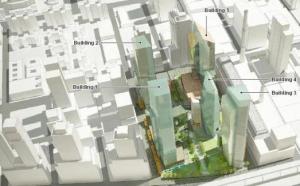As Riverside South Fight Begins, Burden Signals More Affordable Housing Needed
By Eliot Brown June 15, 2010 8:10 pm
reprints The massive 8-acre Riverside South development on the Upper West Side has its first official Community Board public hearing tonight, where, if past criticism is any precedent, the level of below-market rate housing is sure to be an issue.
The massive 8-acre Riverside South development on the Upper West Side has its first official Community Board public hearing tonight, where, if past criticism is any precedent, the level of below-market rate housing is sure to be an issue.
Elected officials and others in the community have called on the developer, Extell Development, to raise the number of such apartments in the planned 2,500-unit project by 59th Street and the West Side Highway. (Extell is currently required to reserve 12 percent of the apartments for below-market rate rents.)
And in an unusual display of a position this early in the process, this is also the view of the Department of City Planning.
At a meeting of the City Planning Commission (which oversees the planning department) on May 24, commission chairwoman Amanda Burden signaled that she wanted to see the housing level move closer to that of the city’s inclusionary housing program, which calls for 20 percent below-market rate apartments. A city planning official said the department would work to “bridge the gap” between Riverside South and the inclusionary program.
“Before we go into any details of the building form, we might as well just hit head on the issue of affordability,” Ms. Burden said after a lengthy presentation and before a question session. “The applicant [Extell] is complying with the Riverside South agreement on affordability and what the obligations are, but Riverside South has parameters that are different from our inclusionary housing program.”
She asked for an explanation of how the Planning Commission would work to “perhaps bring these two concepts more closely together.”
Howard Slatkin, deputy director of strategic planning for City Planning, went on to explain some of the key discrepancies between Extell’s plans for affordable housing and the inclusionary housing program that the city has typically supported for these kinds of developments.
First, he said, “The inclusionary housing program is the department’s preferred approach for incorporating affordable housing into these types of large development proposals.”
Outlining major differences, Mr. Slatkin explained how Extell’s plan essentially includes less affordable housing.
Inclusionary housing requires units to be permanently affordable (in exchange for the permanent floor area bonus provided through zoning), while the proposed term by Extell is 20 years, he said.
Also, compare a 20 percent affordable housing provision, in order to maximize the bonus, under inclusionary housing, to the 12 percent component outlined by Extell—drawn from an agreement struck in the 1990s.
Finally, the way in which affordability is actually measured is also different, he said. Inclusionary housing bases its definition as a percentage of residential floor area, whereas the applicant bases affordability counts on actual unit counts, he said.
“The department will be continuing to work … in an effort to bridge the gap between the project as proposed and the policies that the department and the commission have adhered to on recent large-scale development projects,” he added.
Ms. Burden has said she expects to come to an agreement by early August before the September hearing.
(With reporting by Eliot Brown)


